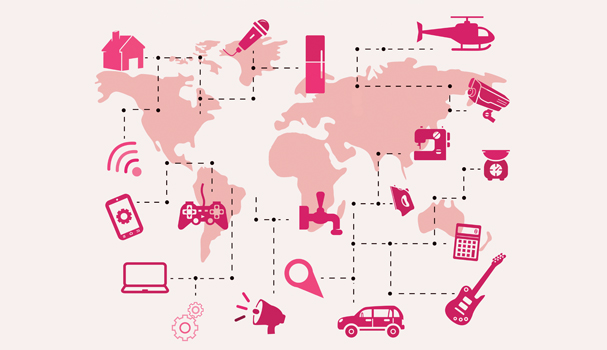You don’t need me to tell you that we live in an increasingly connected world. Connected devices outnumber the world’s population by 1.5 to 1 and around 4.9 billion are set to be in circulation worldwide by the end of 2015. As professional and personal use of these devices has increased, so has the need to explore – and ultimately maximise the potential of – machine-to-machine communication. This has driven huge media, business and societal interest in the internet of things (IoT), culminating in the 2015 Budget, in which the chancellor George Osborne pledged £40m to support the fledgling industry.
This announcement was welcomed across the digital sector, from the start-ups creating the technology to large organisations who know full well the potential of the IoT. Until this point, the majority of IoT product and solution development was focused on the ‘low hanging fruit’ of quick-to-market consumer devices. But it has the potential to be so much more than this.
It can have a life-saving, society-improving, country-wide impact. For example, this could be felt in healthcare, where the technology could be realised in the form of smart health apps or sensor technology to monitor people in need of care who are living alone. Indeed, Gartner has predicted that smart cities will have almost 10 billion connected devices by the time we reach 2020.
Now is the time to take IoT to the next level. We need the realisation of bigger, more complex technologies and concepts, such as smart cities and smart infrastructure all speaking to each other to improve people’s lives. It’s time for IoT to flourish. But it needs more than monetary investment and there are many hurdles to overcome before IoT services and solutions can realise their potential.
For example, smart environment technologies – such as forest fire detection, air pollution control and earthquake early detection – require many different stakeholders all bringing different skills and information to the table. These will include the company developing the technology itself, the input of various environmental data holders, the government, local councils and potentially academics who can bring scientific expertise that businesses or developers may be lacking.
Evidently collaboration between many different parties is needed. The IoT is core to the UK’s economic future and we need to work together to develop these innovations, combining knowledge and resources to overcome challenges and unlock real value. In short, if data is needed in order to make a smart product marketable, then we need to source this and bring all parties together to address that challenge.
As part of the Digital Catapult’s work in IoT, we will enable collaboration between innovators, organisations and academics. Together, they will help put the UK at the forefront of a new wave of applications that will make this country a more competitive place to do business. This will make the UK an IoT leader rather than just an IoT consumer.
As we move forward into an increasingly connected age, the UK needs to make itself a hub of truly open innovation. We can’t afford to let the opportunity slip through our fingers. ![]()
Twelve IoT SMEs to watch
beacontent delivers iBeacon solutions to the events, retail, entertainment and travel sectors. It lets clients identify and communicate with customers, as well as provide enhanced information and value-added engagement
BleepBleeps makes kid-friendly, connected devices to help with the job of parenting. Each BleepBleeps character connects to the BleepBleeps app on a parent’s phone to give them simple guidance and content to make life easier
Blue Maestro is an innovator in wireless, smartphone and internet-enabled healthcare, environment monitoring and control solutions
Briteyellow is an interactive and wireless internet software and services company. Its interactive 3D application provides indoor positioning and navigation of venues like shopping malls, airports and museums
Chirp is a platform for connecting devices with sound. Using a short burst of digital audio, Chirp transfers information from one device to another. Anything that can make sound –including TVs, radios, laptops or doorbells – can chirp
Cupris Health lets users to capture clinical images of the ear and eye. The devices connect to Cupris Health’s web-based service, which allows clinical information to be securely transmitted between healthcare practitioners and their patients. It essentially transforms smartphones into advanced medical devices
Digi.me allows individuals to own all their own data for their own benefit. It also enables individuals to control sharing with businesses, leading to higher engagement and hence value to both businesses and consumers
Labrador unlocks near real-time access to domestic smart energy data, relevant not just to energy suppliers but any company with a household retail proposition. The company helps identify household appliances, customer demographics, household behaviours and interactions and enables smart home functionality
NWave provides low-power, low-cost, long-range communications for IoT. NWave networks connect thousands of devices, providing all the building blocks for low cost, reliable, lightweight LPWA network solutions when and where they are needed
Real Life Analytics turns ‘dumb’ advertising screens into intelligent ones using patented visual recognition technology, enabling every screen to recognise who is in front of it and serve them exactly the right content every time
SonicPaintings creates immersive interactive soundscapes that bring to life stories contained within spaces and images. It utilises sensors, tracking software and web technologies to create unique machine-to-machine interaction, which can benefit the user experience in various contexts, beyond the cultural sector
SPARKL is a nifty piece of code that ties logic to automation. It can be installed inside a computer or other hardware device to automate the way that things work together
Share via:








































